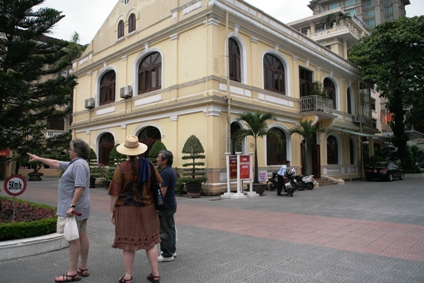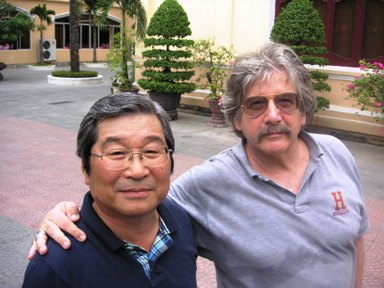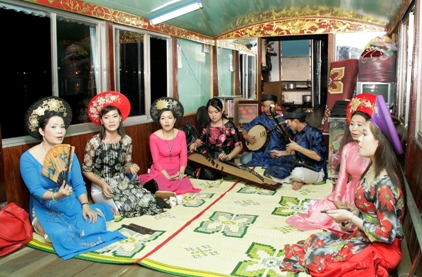| Ken and Bill's Excellent Adventure |
| XVII. The House in Hue, 2011 |
| But the most amazing experience of the entire trip was finding the building Ken and I had been in when we’d been wounded. It took some work to find the building—as we’d already seen, a lot changes in 43 years—but we found it. I wasn’t sure, at first. But the positioning of the house relative to the street, and to the river several blocks away, and the configuration of the windows: this had to be the house. We had been in the room behind that second-floor window. The NVA gunner had fired from one of the buildings across the street. Right: Bill, Anne and Ken in front of the house Bill and Ken were in when they were wounded, left side of building, second floor, right window. No longer a house, the building didn’t look nearly this spiffy in 1968. (SA) |
 |
 Ken & Bill beside the house, now the administrative and business offices for the Duy Tan Hotel, visible on the left and in the background of the previous photo. (AGE) |
The house, which in 1968 had had a brick wall around it, has since been entirely refurbished. Looking fresh, crisp, and bright, it appears to be no older than the six-story four-star hotel built in two sections behind it, the two wings of the hotel forming an L into which the house nestles. The grass lawn has been replaced by a tiled driveway and parking area with a motorscooter rental operation and an outdoor coffee shop. The house itself is now the business and administrative offices for the hotel, the Duy Tan (named for yet another emperor). A young woman inside who spoke English told us that the hotel had been built in 2004, but the house dated to 1920. That was the clincher. This was the place. We were so amazed to be here, alive and happy and 62 years old (well, Ken is 63), that we did not have the presence of mind to ask if we could go up to the very room itself. No matter. This was close enough. |
| That evening, Anne, Ken, and I, accompanied by Sachiko Akama, the photographer who traveled with us, went for an evening cruise on the River of Perfumes. On board with us were eight Vietnamese singers and musicians in traditional garb who performed traditional Vietnamese folk music for us.
When they were finished, they gave us each two paper bags with candles inside. The tradition is to light the candles, make a wish, and set the bags afloat on the river. |
 Singers and musicians who performed for us during an evening cruise on the River of Perfumes, Hue. (SA) |
| Later, standing on a balcony of the Mercure Hue Gerbera Hotel, Ken and I looked out over the city and the river bisecting it. We could see the huge red and yellow Vietnamese national flag flying above the Citadel, illuminated by floodlights, the university that had been used as a refugee center during the battle, the park that had been our helicopter landing zone, the roofs of what had been the MACV compound (Military Assistance Command, Vietnam), even a corner of that building we’d been in when we’d been wounded, now dwarfed by the hotel built around it. But the streets were crowded with noisy, jostling, energetic people on foot, on bicycles, in cars, in buses, and of course on scooters, scooters, and more scooters. Vendors hawked postcards and fresh bread and river tours. The river flowed with colorful tour boats. |
| The bridge, with an unbroken stream of motorscooters going in both directions, blazed yellow to green to blue to purple to red and back to yellow. The Huda beer sign cast a neon ribbon across the water. We did not speak. There was nothing to say. This is what we had come to see. A country. Not a war. Right: Truong Tien Bridge, the River of Perfumes, Hue, at night. (SA) (Background photo by AGE) |
 |
| For more information about writer W. D. Ehrhart, photographer Sachiko Akama, and travel to Japan & Vietnam, proceed to Credits & Contacts |
Copyright © 2011 - W. D. Ehrhart - homepage